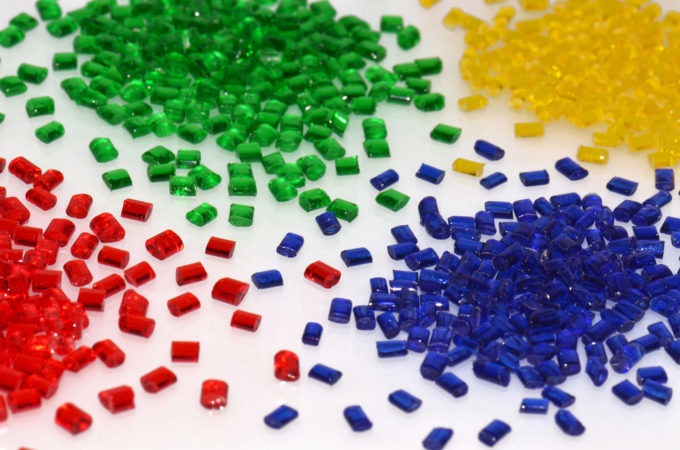Color for plastic injection molded parts can make a big difference in the success of your product. For consumer products, different colors and appearances can help differentiate your offering from those next to it on the shelf (or website). The right color for a product can trigger the subconscious, emotional response that takes a person from “just looking” to “must have.” Color, when used the right way, can also help strengthen and unify your branding strategy to build your reputation in the eyes of your target audience.
Aside from aesthetics, color can also serve a functional purpose in other types of products and parts. Safety equipment, for instance, often must be brightly colored to be extra visible. Critical components in electrical applications, for example, may have color requirements to properly identify and differentiate them. Also, if you are working as a contractor or subcontractor, your client (or its customers) may have color requirements of its own that you must meet.
Fortunately, plastic colorant technology today has evolved to a place where most, if not all, of these types of applications can be met with ease. What’s more, the versatility of colorants for plastics means that entrepreneurs and inventors have more freedom than ever to experiment and think outside the box in terms of the color and appearance of their product, opening the door to more diverse, creative and competitive offerings.
There are still, however, a number of factors to take into consideration when exploring color options for your plastic injection molded parts, and color control is one of the most critical aspects. Often, it’s not enough simply to look at a Pantone chart or list of color options and choose one. You’re likely to have unique customization requests or requirements, so the finer points of color control can become very important. Color control is also critical in reducing your number of iterations (either in prototyping or production) and decreasing the amount of incorrect and discarded pieces yielded — both important aspects of keeping your production costs down.
As part of learning about color control, you’ll want to understand the types of technology available, how they work and the different strengths of each. Even if you are working with an injection molder with a great deal of expertise in plastic colorants, the more information you have at your disposal, the better equipped you’ll be to take an active role in developing and perfecting the color of your product.
Consider the following:

1. Liquid versus solid. Depending on the material you’re using for your product and the type of effect that you’re looking for in its color, you may choose to use either a solid (powdered) or liquid colorant. Each of these is more compatible with certain types of plastics and yields different effects.
Liquid colorants are inherently best for more translucent or semi-transparent effects, and the intensity of the effect can be increased or decreased by changing the amount and concentration of the colorant added to your base plastic. Liquid colorant can yield a “flowing” or “glowing” effect, and is most compatible with PET and PVC plastics.
Solid colorants, on the other hand, mix with the base material to provide a more opaque look. Just like liquid colorants, the concentration of the solid colorant addition can be adjusted to provide a more “intense,” completely opaque appearance, or a lighter (though typically still nontransparent) color.
2. Color versus appearance. Think back to some of the ways we described the effects of colorants above. Often, there’s more to a desired color addition than just the color itself. For instance, you’re unlikely just to say that you want your product to be “green.” You might describe it as a “light green and organic looking, implying eco-friendliness.”

That’s a long way from a Pantone code, and serves as a good illustration of the difference between “color” and “appearance.” Appearance is a highly subjective idea — and even a bit of a moving target, as it can mean something different for everyone — that takes a number of factors and effects into consideration in service of your goals and requirements for your product.
A good plastic injection molder will be able to listen to your ideas for the appearance of your product, and adjust the color formulation as necessary in order to provide what you have in mind. It’s a little bit of art and a little bit of science, so more experience is always better in this area. The best plastic colorant mixers might not even be able to explain exactly their formulation or methodology — they just know that it’ll work (or they know how to get it to work). When you understand that describing the appearance of your product is more important than describing the color, you’re in a better position to help your plastic injection molder produce the results you need.
3. Manage your acceptance criteria. One hundred percent control over your plastic’s color isn’t the goal you want to try to achieve. In fact, it really isn’t possible, as too many variations come into effect. Even if the same machinery is used, differences — no matter how slight — in temperature (both machine temperature and ambient temperature), operator, colorant formulation or concentration and more, will all affect the appearance of the product.
In order to provide an efficient and productive yield (and keep your sanity), you should understand and review these variations prior to (or early in) your production run. Think, again, about appearance: Is the overall effect what you desired, even if the color isn’t exactly what it was supposed to be? Remember also that your customers — whether consumers or industrial buyers — will literally see your products differently than you do. This can help you maintain perspective if you’re inclined to worry about slight differences in color saturation or opacity.
Typical acceptable variations in color range from 10-30 percent — and the more leeway you allow for, the higher percentage of accepted pieces you’ll have from each run, helping with your bottom line, and reducing waste and discarded parts.
By keeping just these three guidelines in mind, you’re in a great position to act as an informed and productive partner in your plastic injection molding process — and to see the numerous benefits that this provides you.



